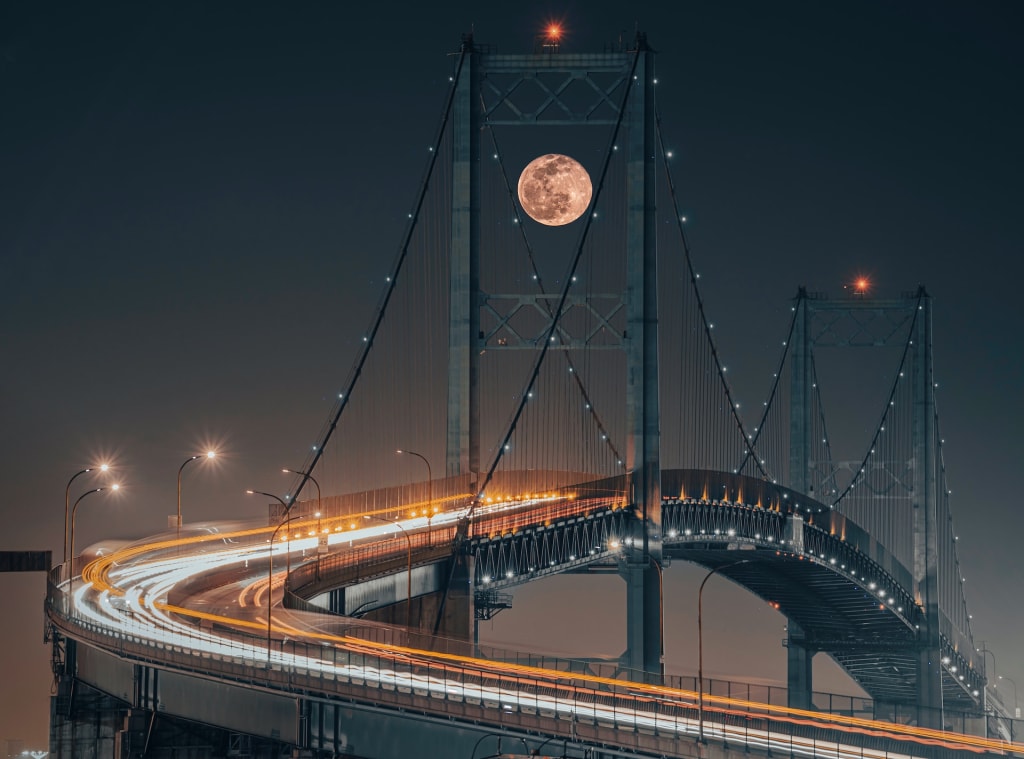Bridge To The Moon: The Bridge Itself
Chapter Four: The Bridge Itself

(In which Great-great-great-great-great-great-granddad recounts what he recalls of that great, great, great, great, great, great piece of infrastructure he once traversed, so very, very, very, very, very, very long ago - and tells of an averted disaster.)
Great-great-great-great-great-great-granddad: Looking out of the windows of the train, you usually couldn’t see that great, (mostly carbon), marvel of a bridge, due to the darkness of space - but sometimes light would hit it from somewhere, usually light from inside the train. In fact there were certain parts of the train where you could usually see the bridge - like the forward observation deck, where you could see the light from the headlights, lighting up the bridge ahead. I believe that was monitored by artificial intelligence, which also used other means to scan the way ahead, in case of any unexpected surprises; and of course, there were all sorts of scanners and monitors all over the bridge, from one end to the other.
There were robotic machines - every hundred kilometres I think - to carry out necessary repair work; with materials stores they accessed, which I believe were on the “bottom” side of the bridge - although it’s really arbitrary to call one side of the bridge the top and the other side the bottom, when it’s going straight up. What I really mean by the “bottom” side of the bridge when it’s reaching across the chasm of space, is the side of the bridge that the train isn’t travelling along.
About every thousand kilometres - I think - there was a passing lane where one train could wait for another to overtake it, or to pass by in the opposite direction. They also had spaceports at these places, where a spacecraft could land in case of an emergency of some sort.
There were also various ways to deal with any incoming foreign objects. I believe there were lasers that could shoot small items and vaporise them - for larger items they had to move that item, (or the bridge), out of the way, or open up a temporary gap in the bridge, provided they had enough warning. And given that all things in orbit around the Earth or the Moon were being tracked continually, and objects coming from elsewhere could usually be seen in plenty of time, this wasn’t a great problem. When you consider the vastness of space, even just between the Earth and the Moon: the bridge - even though it was incredibly long - wasn’t really that big a target.
However, a couple of hundred years earlier, in the twenty-first century, there were millions of human-made items orbiting Earth, with a lesser number orbiting the Moon - mainly bits of things that had fallen off satellites or rockets, or broken satellites themselves, or even flakes of paint that had come away from satellites - all potential threats to a bridge, or a train, or people, traversing space from the Earth to the Moon. (Yes, even paint flakes when you consider that they’re travelling at thousands of kilometres per hour!) Fortunately, all this space waste was removed long before the bridge was built.
Great-great-great-great-great-great-granddaughter: Did a train ever come off the bridge, Great-great-great-great-great-great-granddad?
Great-great-great-great-great-great-granddad: Well yes, there was a time when a gap in the bridge was opened to avoid an asteroid that couldn’t possibly be nudged out of the way in time. After the asteroid had flown past, they didn’t have time to close the gap they’d opened, and the train - and the track it was clamped onto - just sailed off the bridge and kept going on its own, through space. They didn’t even attempt to stop the train before it came off the bridge, (only to slow it enough to avoid the asteroid), because it was going way too fast, and a sudden stop would have killed everyone onboard due to the immense g forces: and even if anyone had somehow survived that, they may have been killed anyway, because the train carriages could have broken up from within, and bits of train carriage and furniture and fittings could have crashed into people onboard, as the train came to a sudden stop.
Fortunately, the bridge was moved a little to one side as the gap was opened to let the asteroid through, (as part of standard safety measures). Therefore, when the train flew off, it didn’t crash into the bridge further on, but kept heading towards the Moon. They managed to intercept the flyaway train with a spaceship that docked to the back of the train, and the spaceship used its rocket thrusters to steer the train the way they wanted it to go. (In such circumstances, they would use mechanisms which were already part of the train, to reinforce the joints between the carriages - and the same thing goes for the track the carriages were on - in such a way as to make the entire train and track straight and stiff, instead of bending at each connection between carriages.) They also managed to dock another spaceship to the front of the train - and that spaceship, which had its thrusters facing in the direction the train was heading, was able to fire them to slow the train down. Then they used the first spaceship, at the back of the train, to fire its thrusters to move the train back onto the bridge, and a major catastrophe was avoided.
Great-great-great-great-great-great-granddaughter: Didn’t they know the asteroid was coming, Great-great-great-great-great-great-granddad?
Great-great-great-great-great-great-granddad: Well, this happened during the Moon War, and evil forces were actually trying to ensure the train was hit by the asteroid. Fortunately the plot was discovered in time to avoid disaster.
Next time:
Chapter Five L1
(or read the whole story here: https://vocal.media/fiction/bridge-to-the-moon)
About the Creator
Nicholas Edward Earthling
Hello fellow earthlings. I am one of you! I hope you're happy about that.
I'm an Australian retiree who wants to write as a hobby, and perhaps have some critical and commercial success. However, I do value my privacy so won't be oversharing.
Enjoyed the story? Support the Creator.
Subscribe for free to receive all their stories in your feed. You could also pledge your support or give them a one-off tip, letting them know you appreciate their work.






Comments
There are no comments for this story
Be the first to respond and start the conversation.